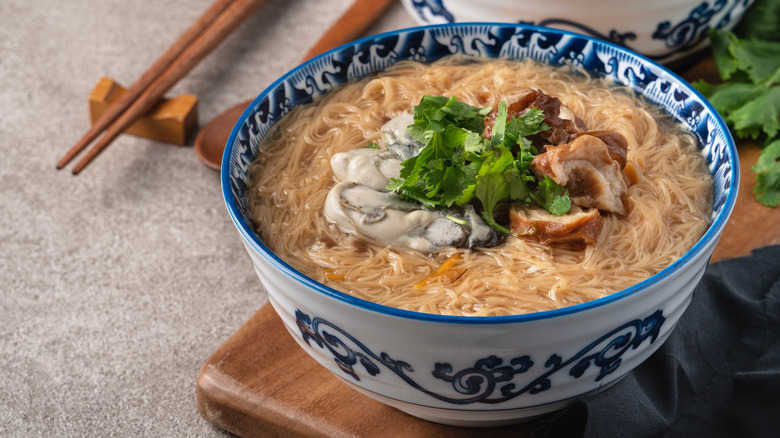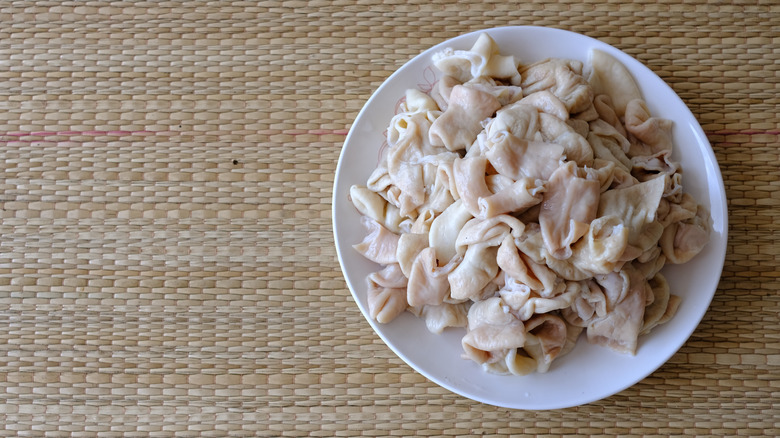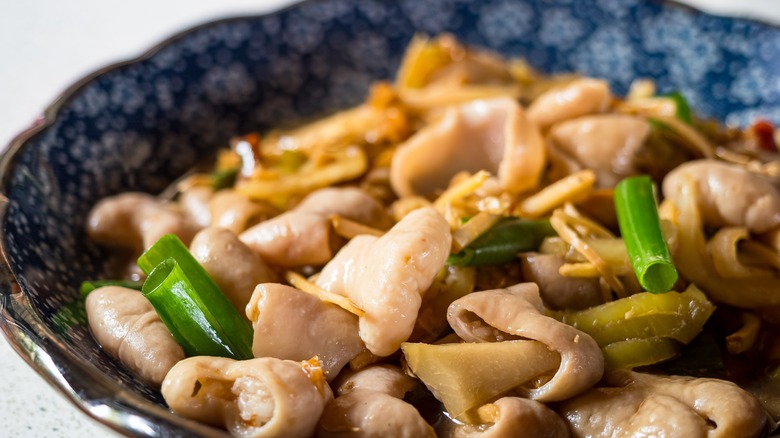What Exactly Is Pork Bung And How Do You Prepare It?
Many traditional cuisines have creative, resourceful ways to use the various parts of butchered meat. Think: jerk pork belly or pork belly skin fried into Colombian chicharrones, chicken gizzards made into chopped liver, and cow tongue simmered into a soft, silky texture. These are all types of organ meat (or cuts referred to as offal), that when cooked delicately are lusciously delicious.
One such organ meat you may not be familiar with is pork bung: the large intestine and rectum of a pig. Fried and served as street food, or served atop a bowl of steaming hot noodle soup in Chinese and other Asian cuisines, or with pillowy tortillas and acidic, spicy sauces in Mexican dishes, pork bung is a beloved part of a meal — when prepared correctly.
As with stomach, tongue, and other fatty offal meat cuts, such as small intestine (or tripe), it's essential to know how to cook pork bung so it's moist and juicy, not overly tough when you take a bite. There are a few methods to prepare pork bung that is soft and silky: boil it in a stew or soup, parboil and simmer the intestines in a flavorful sauce, or boil and fry the animal innards to give them a crunchy exterior that balances the velvety insides.
Tips for cooking pork bung
Ready to try your hand at cooking pork bung at home? First, check the frozen aisle of a local Asian grocery store or butcher counter (which might have it in stock, as the organ is often used for making sausage casings). Pork large intestine is a long, fatty tube. Usually the last couple feet of the organ is turned inside out, cleaned, and packaged in plastic wrapped containers.
If needed, thaw pork bung in the fridge prior to cooking it. Because the organ's function is to pass waste, it's typically turned inside out and cleaned well prior to packaging. But typically, you'll want to give it a solid rinse under cold water when you're ready to prepare it. Some traditional cooking methods call for simply boiling the sliced or whole organ in water, or a bath of seasoned soup broth or stew, for at least an hour. Enjoy the boiled meat in soups, or coat it in batter or seasoned flour, stuff it with scallions, and fry it in the deep-fryer or in a pan.
To give it a tenderizing head-start or want to simmer the intestine in a sauce, first soak it in water and vinegar. To prepare it for simmering in curry, boil the intestine for a few minutes until just soft, then run under cold water or in an ice bath so it doesn't keep cooking (and become chewy) prior to simmering in the sauce until it's tender.
Serve pork bung with complimentary flavors and textures
Cooked right, so it's tender and soft, pork bung will be melt-in-your-mouth delicious. But as with other offal meats, it's important to pair pork bung with flavorful sauces, dips, and dishes to complement and enhance the fact that you're eating an organ cut that's quite fatty.
When adding pork bung to a simmer sauce, choose to coat it in cooking liquid that is salty, spicy, or acidic to balance the fatty bite. Serve pork bung in its cooking liquid for rich, comforting hot soups, such as Jjambbong (Korean-Chinese spicy noodle soup). To enjoy the organ boiled and deep-fried, slice it diagonally into bite-sized pieces, and serve on skewers or alongside citrusy-soy Japanese ponzu dipping sauce, or other tasty soy sauce varieties.
You can also serve pork bung chopped into small pieces and tossed in a wok with fried rice, topped with kimchi for a fermented acidic bite. Whatever way you serve it, if you prepare pork bung with care, it will turn out soft and silky — the perfect compliment to a variety of dishes.


